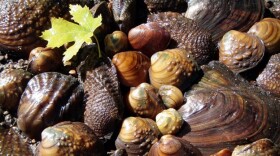Next year, we might remember that we didn’t have much snow this winter. But how do we keep track of things like this? The most obvious way is to collect and safeguard data for as long as possible. But there are other kinds of record keeping that scientists use to recapture recent and ancient history. Call me a luddite, but I have more confidence in physical records of history than electronic ones.
One kind of long-term data storage close to my heart is an herbarium collection, a place where dried, pressed plants are stored. The process is simple, and maybe you have done this with kids or grandkids. You collect a plant and dry it between some sheets of absorbent paper. Once dried, the plants can be mounted on acid-free herbarium paper, given a label with the plant name, date of collection, location and any other information you have. These specimens will last for hundreds of years. It is possible to visit an herbarium with plants that were named and preserved by the 18th century father of taxonomy, Carl Linnaeus himself. Last summer I found an uncommon plant in a lake in Iron County. I pressed it and checked for other records of this plant at the University of Wisconsin herbarium website and discovered this same species was collected from this same lake back in 1965!
A sediment core taken from the bottom of a lake is another storehouse of information. Lake bottoms record what has gone on in the lake and the surrounding landscape over the life of the lake – around here that could be up to ten thousand years. Pollen and plant bits from a succession of vegetation types in and around the lake, resistant parts of zooplankton, smoke and soot from nearby fires, mud and sand from erosion, all drift to the bottom of the lake, and slowly accumulate. As the drifting stuff piles up, the sediment becomes a continuous historic record of the area. To collect a sample, scientists connect a series of pipes to reach all the way from the surface of the lake to the bottom. They may stage this in winter on the ice since this is a more stable platform than a boat on open water. The special, bottom-most pipe is driven into the muck to collect a cylinder of mud. Once back at the surface, the scientist extrudes the mud, slicing and examining thin wafers of sediment. They find bits from plants and animals in the slices, and since many of them live within a narrow range of conditions, they can reconstruct what the lake and the surrounding land was like in the past. Using several tools, they can assign an age to the different layers. For example, nuclear bomb testing from 1963-1965 deposited a tracible radioactive layer of Cesium 137. This works as a benchmark for dating the strata.
Analogous to the lake sediment samples, scientists can reconstruct the earth’s history for far longer from cores taken from glaciers and ice sheets. Glaciers start out as snow, and then as new snow falls, older snow is buried, and becomes compressed, eventually becoming clear ice. Scientists drill into the ice and extract a cylinder of ice that can be sliced and tested for several variables. Using some fancy chemistry, they can reconstruct the air temperature from when the ice formed. They can also measure how much carbon dioxide and methane were in the air at the time the snow fell. Because there is next to no melting at the surface, the cores accurately reflect the conditions from when the snow was first deposited. The oldest continuous ice core records extend to 130,000 years in Greenland, and 800,000 years in Antarctica. These cores can be up to 3km or almost 2 miles deep. Records from ice cores and other data reveal that our global temperatures, which have risen with atmospheric carbon dioxide levels, are now higher than at any point in the last 1,500 years.
So we have an herbarium to document changes in plants over the last several hundred years, sediment cores to document changes in lakes and their surrounding lands over the past several thousand years and ice cores to document changes to the planet over more than a hundred thousand years. Given the short life and ever-changing nature of our electronics, I am convinced the plants I have preserved in my herbarium will be the only record of anything I ever did. Even if scientists lose data they think they have carefully stored on our present-day electronic devices, the herbarium plants, the sediment cores and ice cores can be re-examined so we can re-learn whatever is lost.









